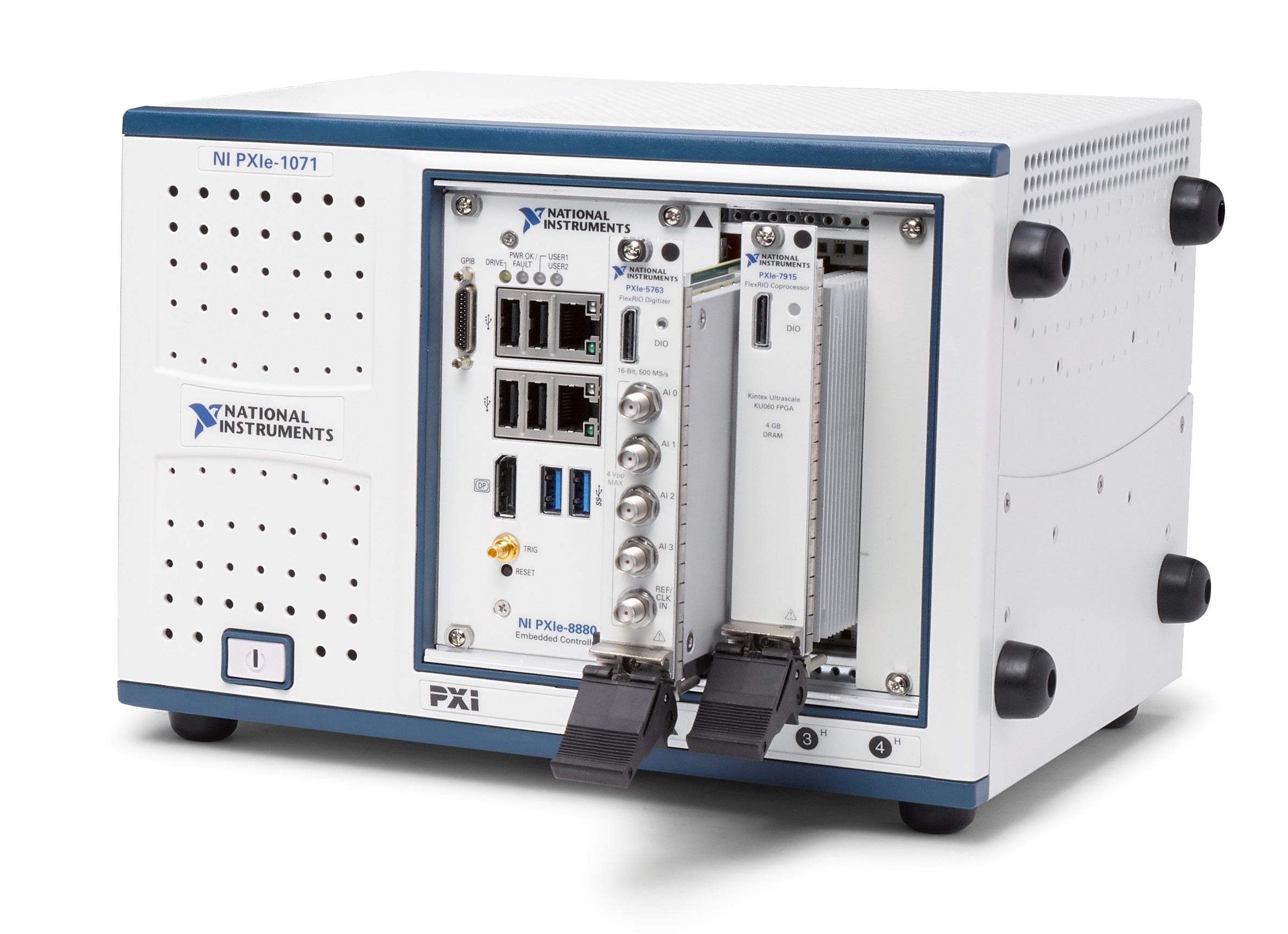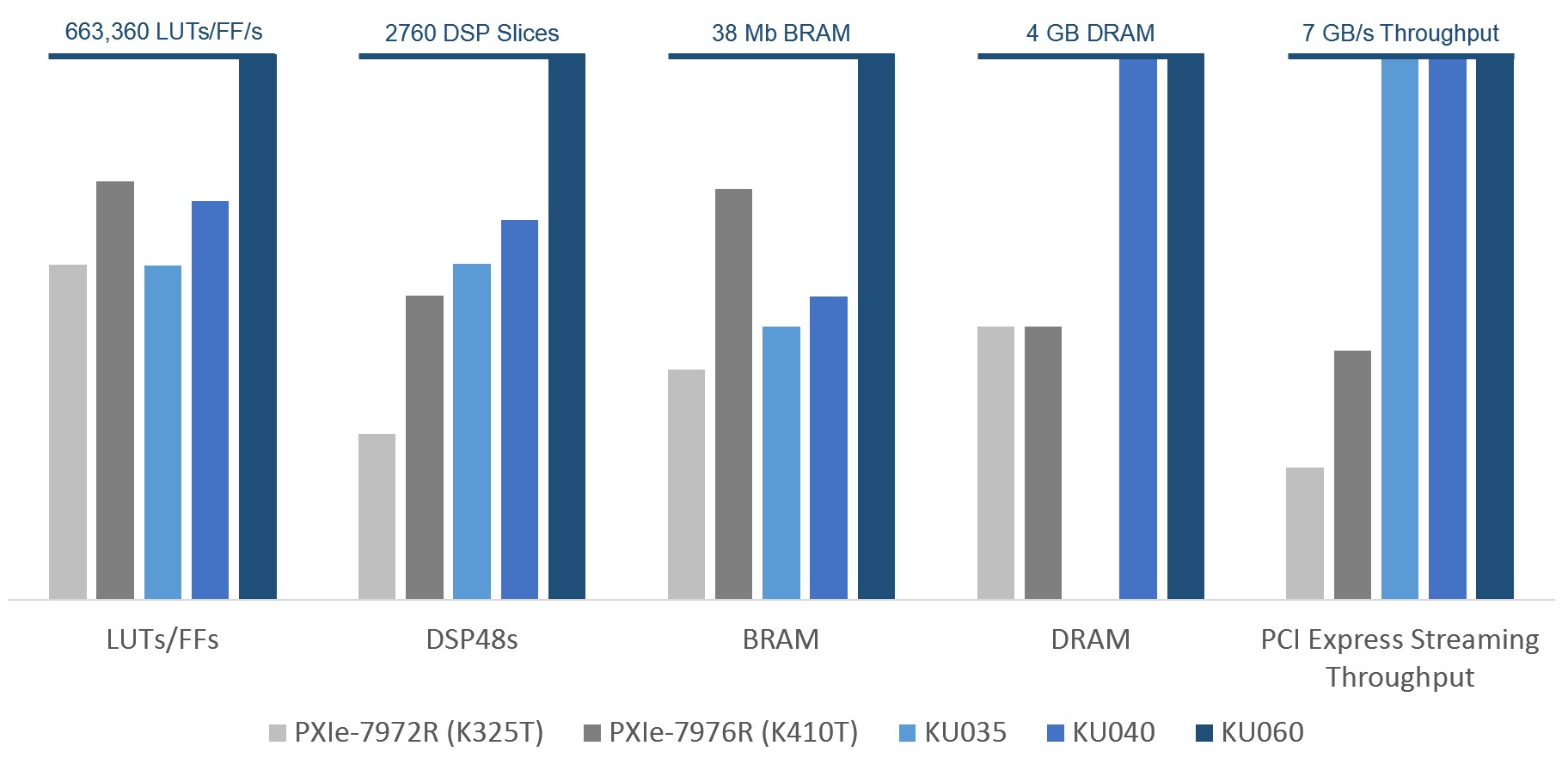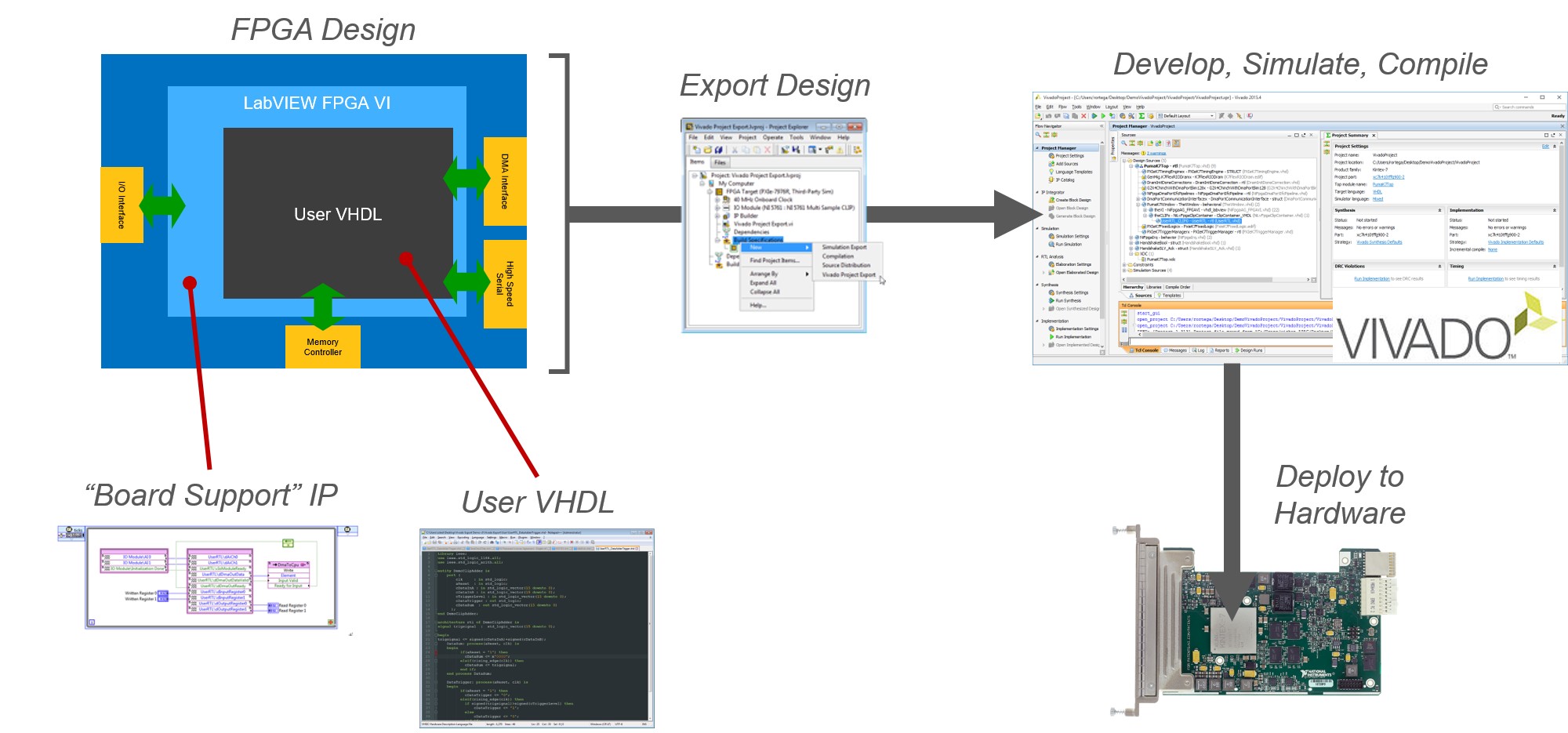Introduction to the New FlexRIO Modules with Xilinx Kintex UltraScale
Overview
Contents
- A New FlexRIO Architecture
- Integrated, Mezzanine I/O
- Xilinx Kintex UltraScale FPGA Backends
- Synchronization With NI-TClk
- Ease Into FPGA Programming
- Xilinx Vivado Support for Experienced Digital Engineers
- Next Steps
Figure 1: The new FlexRIO modules use high-speed serial converters and feature integrated I/O and Xilinx Kintex UltraScale FPGA technology in a single device.
A New FlexRIO Architecture
A key advantage of the FlexRIO product line is that you can take advantage of the latest high-speed data converter technologies before they are widely available in traditional COTS instruments. This is particularly valuable in applications that continue to push requirements for sample rate, bandwidth, resolution, and channel count.
Driven mainly by performance requirements of applications in the RF space, data converter manufacturers continue to innovate with higher speed, higher resolution parts. It is no longer uncommon to see analog-to-digital converters (ADCs) or digital-to-analog converters (DACs) with 12 bits of resolution at over 4 GS/s or even converters with 16 bits of resolution at over 500 MS/s. Although these high-speed parts are attractive for a variety of applications, the underlying technology for communicating with the latest converters has shifted away from wide low-voltage differential signaling (LVDS) interfaces toward high-speed serial interfaces running protocols like JESD204B.
Figure 2: The original FlexRIO architecture was well suited for traditional converters with single-ended or LVDS interfaces for data communication. The new FlexRIO architecture was designed to interface with the industry’s latest high-speed converters based on high-speed serial interfaces running protocols like JESD204B.
To stay ahead of this industry trend and continue delivering the latest commercially available technologies, NI has developed a new FlexRIO architecture. Instead of the parallel digital interface of the previous architecture, the new FlexRIO products are based on high-speed serial communication between a mezzanine I/O module and a Xilinx Kintex UltraScale FPGA backend.
Figure 3: The new high-speed serial FlexRIO products are composed of a mezzanine I/O module mated to a Xilinx Kintex UltraScale FPGA backend.
Integrated, Mezzanine I/O
The electrical interface between the FlexRIO FPGA and I/O module needed to be completely redesigned because high-speed serial communication relies on the FPGA’s multigigabit transceivers. Adopting a mezzanine connector for this interface meant that this time around the I/O module could be mated directly to the FPGA backend, forming a single integrated PXI module. Yes, the new FlexRIO products do not stick out of the chassis.
With the new architecture, FlexRIO modules are identified by a model number corresponding to the capability of the mezzanine I/O module. You can then choose the FPGA backend that best meets your requirements. For example, the PXIe-5764 is a 16-bit FlexRIO digitizer that samples four channels simultaneously at 1 GS/s. You can pair the PXIe-5764 with one of three FPGA backend options detailed in Table 1.
Table 1: The first two new FlexRIO digitizers offer a powerful combination of dynamic range, sample rate, and channel count.
Model | Channels | Sample Rate | Resolution | Coupling | Bandwidth | FPGA Options |
PXIe-5763 | 4 | 500 MS/s | 16 bits | AC or DC | 227 MHz | KU035, KU040, KU060 |
PXIe-5764 | 4 | 1 GS/s | 16 bits | AC or DC | 1.15 GHz* | KU035, KU040, KU060 |
*Maximum bandwidth for a full scale input signal is 400 MHz.
Xilinx Kintex UltraScale FPGA Backends
The new FlexRIO products gain a significant bump in signal processing horsepower with Xilinx Kintex UltraScale FPGAs. FlexRIO with Kintex UltraScale sets the new standard for FPGA-based signal processing in PXI with 80 percent more digital signal processor (DSP) slices, 30 percent more BRAM, and PCI Express Gen 3 x8 connectivity for data streaming. You can choose from a range of FPGA backend options depending on your application requirements. However, for new applications, it is always better to start with the largest FPGA possible and downsize later.
Table 2: What size FPGA do you need? With the new FlexRIO products, you can choose from three FPGA backends.
FPGA | LUTs/FFs | DSP48s | BRAM (Mb) | DRAM (GB) | PCI Express | Aux I/O |
Xilinx Kintex UltraScale KU035 | 406,245 | 1,700 | 19 | 0 | Gen 3 x8 | 8 GPIO |
Xilinx Kintex UltraScale KU040 | 484,800 | 1,920 | 21.1 | 4 | Gen 3 x8 | 8 GPIO 4 GTH |
Xilinx Kintex UltraScale KU060 | 663,360 | 2,760 | 38 | 4 | Gen 3 x8 | 8 GPIO 4 GTH |
Figure 4: The three new UltraScale FPGA options (blue) provide a significant performance increase compared to the Kintex-7 FPGA Modules for FlexRIO (grey), at a range of price points.
The new FlexRIO modules are equipped with PCI Express Gen 3 x8 connectivity, making them capable of streaming up to 7 GB/s via DMA to/from CPU memory. Or, with NI peer-to-peer streaming technology, you can stream data between two modules in a chassis without passing data through host memory. Learn more about peer-to-peer streaming technology.
Auxiliary I/O
All three FPGA backend options feature front-panel auxiliary digital I/O through a Molex Nano-Pitch I/O connector for triggering or digital interfacing. On the larger FPGA backends, four additional GTH multigigabit transceivers, each capable of data streaming up to 16 Gb/s, are routed to the Nano-Pitch I/O connector. These transceivers can be used for high-bandwidth communication with other devices over high-speed serial protocols such as Xilinx Aurora, 10 Gigabit Ethernet UDP, 40 Gigabit Ethernet UDP, or Serial Front Panel Data Port (SFPDP).
Dedicated FlexRIO Coprocessor Modules
If you are looking to add signal processing capability to an existing system, dedicated coprocessor modules are available as well. FlexRIO coprocessor modules offer specialized mechanicals for optimal thermal performance and can communicate over the backplane via PCI Express Gen 3 x8 or over high-speed serial through the Nano-Pitch I/O connector on the front panel.
Table 3: FlexRIO Coprocessor Modules add signal processing capability to an existing system.
Model | FPGA | PCI Express | Auxiliary I/O |
PXIe-7911 | Kintex UltraScale KU035 | Gen 3 x8 | None |
PXIe-7912 | Kintex UltraScale KU040 | Gen 3 x8 | 8 GPIO, 4 GTH |
PXIe-7915 | Kintex UltraScale KU060 | Gen 3 x8 | 8 GPIO, 4 GTH |
Synchronization With NI-TClk
Synchronizing multiple modules in a system is often the most difficult part of designing high-channel-count solutions. Many COTS vendors have solutions for synchronization that don’t scale and, with custom designs, it can take significant expertise to meet common requirements for phase alignment across channels. FlexRIO modules take advantage of the inherent timing and synchronization capabilities of the PXI platform, directly accessing the clocks and trigger routes shared with other instruments. The new FlexRIO products have support for NI-TClk, which orchestrates synchronization to ensure all modules are aligned to the same start trigger. Learn more about NI-TClk technology.
Figure 5: The new FlexRIO Digitizer Modules support NI-TClk for subsample synchronization between modules.
Ease Into FPGA Programming
It doesn’t have to be difficult to take advantage of instruments with FPGAs. The software behind the new FlexRIO products provides the flexibility to implement a custom FPGA design from scratch or the support of starting from a host-based streaming driver. The new FlexRIO streaming driver was designed to support basic digitizer and arbitrary waveform generator functionality without requiring FPGA programming. The driver supports finite or continuous acquisition/generation on any high-speed serial FlexRIO products with analog I/O and is intended as a high-level starting point before further customization on the FPGA. In addition to basic streaming functionality, you can use the driver for configuration of the I/O module’s analog front end, clocking, and even direct register reads/writes to the ADCs or DACs.
Xilinx Vivado Support for Experienced Digital Engineers
Experience digital engineers can use the Xilinx Vivado Project Export feature included with LabVIEW FPGA 2017 to develop, simulate, and compile for FlexRIO hardware with Xilinx Vivado. You can export all the necessary hardware files to a Vivado project that is pre-configured for your specific deployment target. Any LabVIEW signal processing IP used in the LabVIEW design is included in the export; however, all NI IP is encrypted. You can use Xilinx Vivado Project Export on all FlexRIO and high-speed-serial devices with Kintex-7 or newer FPGAs.
Figure 6: For experienced digital engineers, the Vivado Project Export feature can export all necessary hardware design files to a Vivado project for development, simulation, and compilation.





